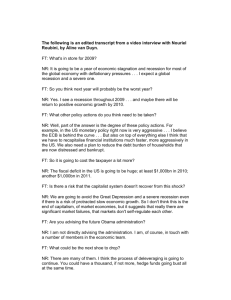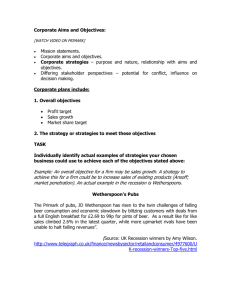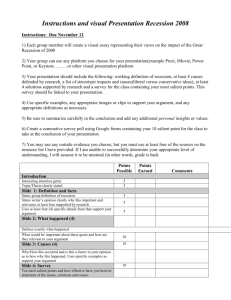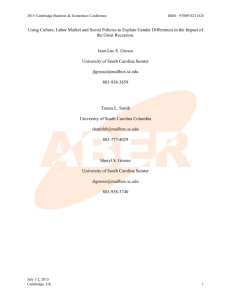September 2015
advertisement
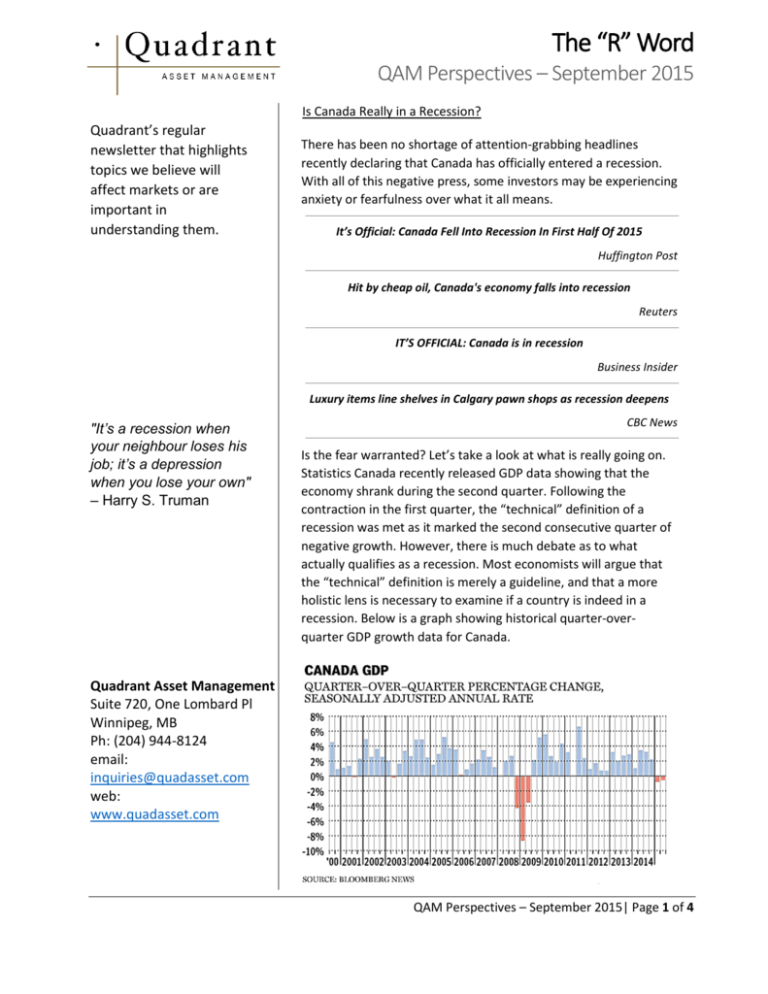
The “R” Word QAM Perspectives – September 2015 Is Canada Really in a Recession? Quadrant’s regular newsletter that highlights topics we believe will affect markets or are important in understanding them. There has been no shortage of attention-grabbing headlines recently declaring that Canada has officially entered a recession. With all of this negative press, some investors may be experiencing anxiety or fearfulness over what it all means. It’s Official: Canada Fell Into Recession In First Half Of 2015 Huffington Post Hit by cheap oil, Canada's economy falls into recession Reuters IT’S OFFICIAL: Canada is in recession Business Insider Luxury items line shelves in Calgary pawn shops as recession deepens "It’s a recession when your neighbour loses his job; it’s a depression when you lose your own" – Harry S. Truman CBC News Is the fear warranted? Let’s take a look at what is really going on. Statistics Canada recently released GDP data showing that the economy shrank during the second quarter. Following the contraction in the first quarter, the “technical” definition of a recession was met as it marked the second consecutive quarter of negative growth. However, there is much debate as to what actually qualifies as a recession. Most economists will argue that the “technical” definition is merely a guideline, and that a more holistic lens is necessary to examine if a country is indeed in a recession. Below is a graph showing historical quarter-overquarter GDP growth data for Canada. Quadrant Asset Management Suite 720, One Lombard Pl Winnipeg, MB Ph: (204) 944-8124 email: inquiries@quadasset.com web: www.quadasset.com QAM Perspectives – September 2015| Page 1 of 4 The “R” Word QAM Perspectives – September 2015 In relation to the last recession in 2008/2009, the GDP figures for this year don’t look terribly compelling. In fact, June actually had positive GDP growth. Consumer spending and employment were up in both quarters, which are usually two of the indicators most prone to decline in a typical recession. Furthermore, Statistics Canada revises the official GDP data a few months after each release, so there is a possibility that the numbers may be still changed. If the “official” GDP statistics for the second quarter are revised upwards into positive growth territory, does that suddenly rescind the so-called recession? Regardless, the R-Word will likely be thrown around a lot in the political sphere, given that we are currently in an election period. Even if we are not really in a true recession, Canada is certainly experiencing an economic slowdown. For the most part this was to be expected, considering the sharp decline in the price of oil prior to the first quarter. Slowing growth in China has exacerbated these effects, as reduced commodity demand has been weighing on prices. Additionally, the fact that China has slightly devalued its currency in an attempt to boost exports has many analysts fearing that its real growth numbers are significantly lower than what is being reported by the opaque National Bureau of Statistics of China. On the plus side, besides the energy and mining sectors, many other areas of the economy are growing. Higher consumer spending on the strength of the housing market as well as a modest jump in automotive exports has helped to mitigate the negative effects of setbacks in the energy sector. An improving economy in the United States, Canada’s largest trading partner, also provides some positive growth potential. It is important to keep in mind that while economics and investing are certainly related, economic data tends to describe the past while the investment world needs to look into the future. GDP is a backward looking metric that attempts to gauge the strength of the economy over a particular period of time. By the time the official Q2 data was released in September, the Canadian economy was probably already on a better track towards growth. This said, there are some potential risks going forward to be cognizant of that may continue to weigh on the economy. Prolonged low oil prices may spark further job cuts, primarily in Alberta, that could have ripple effects on the housing market and debt default rates. The depreciation of the Canadian dollar has been a positive for the manufacturing sector as it makes prices more competitive in the global marketplace, but currency devaluation by other countries that are also experiencing slowdowns may be muting that benefit. Furthermore, business investment is inhibited in some sectors by the depreciated Loonie as it makes capital expenditures more expensive for companies that need to import machinery from outside of Canada. QAM Perspectives – September 2015| Page 2 of 4 The “R” Word QAM Perspectives – September 2015 Will my investment portfolio be affected by any of this? Going forward, moderate to muted returns should be expected from the capital markets as a result of global macroeconomic circumstances. The Canadian economy alone does not have a major effect on a diversified portfolio. However, considering that many of the factors that are weighing on the Canadian economy are also affecting other developed nations, volatility across multiple asset classes is likely to increase over the remainder of the year. It seems that many investors tend to fixate on avoiding inevitable periodic market corrections and fail to appreciate the good periods. Below are the returns from a few major asset classes over the past six and a half years (Feb. 28, 2009 – Aug. 31, 2015). Comparing a 10-20% (or even 20-30%) equity market correction to the major returns experienced during the current bull market, it seems less disastrous. *All returns are expressed in Canadian dollar terms Benchmark Index Asset Class Total Return S&P 500 Index U.S. Equities 221% S&P/TSX Composite Index Canadian Equities 106% MSCI EAFE Index International Equities 129% FTSE TMX Canada Universe Bond Index Canadian Bonds 38% Source: Bloomberg QAM’s asset class managers are monitoring the markets and adjusting positions as necessary. In the investment world, it is important to view the environment analytically in terms of opportunities and threats, and to not let emotions dictate actions. As prices retreat in the market, valuation multiples contract and can provide opportunity for an investor to purchase the earnings of a company at a bargain price. Many equity managers have been increasing cash levels throughout the year in anticipation of a market correction, and are well positioned to buy quality companies at bargain prices. Volatility and periods of negative returns are a fact of life in the capital markets, and due to the higher risk premium associated with owning equity, stocks exhibit a higher level of volatility than other asset classes such as cash and bonds. Over a long term horizon, investors need not fret periodic declines. These periods, although possibly frightening and stressful when endured, are responsible for the long term outperformance of equities. The debate over whether Canada is actually in a recession or not is a moot point. The capital markets have recently been experiencing heightened volatility, not due to a periodic contraction of the Canadian economy, but rather due to global macroeconomic issues such as slowing growth in China, instability in Europe, and a weak commodity environment. In times like this, it is important that investors remain calm and understand that long term investment portfolios are designed to filter out the noise and weather turbulent times. QAM Perspectives – September 2015| Page 3 of 4 The “R” Word QAM Perspectives – September 2015 Disclosures This report is prepared for the use of Quadrant Asset Management personnel and clients and may not be redistributed, retransmitted or disclosed, in whole or in part, or in any form or manner, without the express written consent of Quadrant Asset Management. Any unauthorized use or disclosure is prohibited. The information herein was obtained from various sources and Quadrant Asset Management does not guarantee its accuracy. Neither Quadrant Asset Management nor any director, officer or employee of Quadrant Asset Management accepts any liability whatsoever for any direct, indirect or consequential damages or losses arising from any use of this report or its content. QAM Perspectives – September 2015| Page 4 of 4


